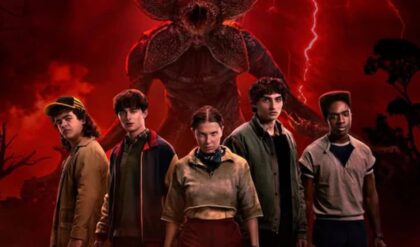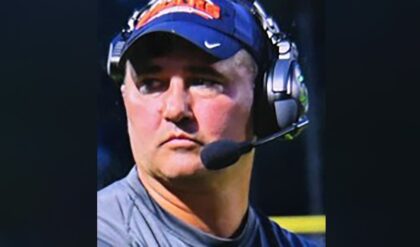
FROM
Credit: MGM
Like all great shows that make true detectives of the fan community, FROM has grown into one of the most-discussed and puzzled over TV shows out there, with fan theories in abundance. After all, there are so many mysteries and most of the clues up this point have been cryptic at best. Top that off with some red herrings and classic misdirection, and you have a really fun puzzle to solve, even if we don’t have enough pieces yet to solve it.
In any case, the theory I like best—which I thought of and wrote about previously, but so did a lot of other people concurrently—is one that some viewers might find very peculiar: FROM is actually a fairy tale. It’s not the kind we’ve grown accustomed to in modern American culture and the faeries in this show are, if anything, very distant cousins of Tinkerbell. But a lot of clues indicate that this is some kind of dark fairy tale filled with wicked fae. Here are a few of the pieces of evidence that point to this theory being true:
Faeries are often wicked or at least morally ambiguous in old stories. Many people believed that faeries were capable of all sorts of wicked tricks: Stealing babies or children and replacing them with changelings, making devilish bargains, trapping people in the Otherworld for eternity. The wicked Fomorians were the enemies of the Tuatha Dé Danann. The Unseelie Court is the bastion of malevolent faeries who harm humans for their amusement or to exact revenge. The Germanic nightmare fae, the Alp, causes night terrors by sitting in the chest of a sleeping human. The French Lutin fae can turn malicious if insulted, ruining crops and frightening animals.
In more recent works, you could point to the villains of Tolkien or other fantasy authors. Tad Williams’ fantasy series Memory, Sorrow and Thorn features the sidhe as villains. Susannah Clarke’s Jonathan Strange & Mr Norrell is perhaps the best example in modern literature when it comes to evil faeries trapping humans in the Otherworld thanks to diabolical bargains.
There is much evidence of the fae in FROM. For instance, people used to hang iron on their doors at night to keep faeries and demons out of their homes (talismans) and a knock on the door in the middle of the night was to be ignored, for surely some evil spirit was lurking outside. Magical trees are common enough in faerie stories, and the Faraway Tree certainly sounds like something you’d find in a fairytale. Indeed there are a series of children’s books that go by that same name, about children who find themselves in an enchanted forest inhabited by elves.
The symbols on the talismans and the symbol that Jade sees in his visions could easily be interpreted as occult, with a mixture of Celtic, Norse and Mesoamerican glyphs. I suspect that if this is a faerie story, it will not be confined to a single folkloric tradition, given that—for one thing—we are in America rather than Ireland or Scandinavia. The esoteric nature of the symbols could mean anything, and are certainly up for interpretation, but the talismans appear to be wards of some kind.
By signing up, you agree to our Terms of Service, and you acknowledge our Privacy Statement. Forbes is protected by reCAPTCHA, and the Google Privacy Policy and Terms of Service apply.
Then there is the town itself, and the magical forest that surrounds it, and while this magical town is more Americana than Celtic, it’s very much the perfect setting for a fae realm in the US. And if you’re in America, what better portal to the fae than via a car, on a highway?
The focus on stories is important. Sure, we get most of this from young Ethan, who is obsessed with his fables and fairytales, but I think that’s on purpose. I think it’s extremely important, in fact, to both the characters in the story and our understanding of the story. We are watching a dark fairytale, and Ethan is the only character who really sees it for what it is. His love for The Flight Of The Cromenockle helps frame his own experience in the town, but I think it’s also a clue about the nature of the story we’re watching.
The opening theme song—Que sera, sera—is performed by The Pixies. If that’s not a massive clue as to the nature of the evil spirits we’re dealing with, I’m not sure what is. It’s subtle, sure, but I don’t think it’s a coincidence. I don’t believe in coincidences. (Sorry, that’s my hard-boiled detective voice coming through). The title sequence and song are actually a little bit reminiscent of True Detective on HBO, and that’s interesting because . . . .
The Man In Yellow is almost certainly at least a nod to The King In Yellow. I discuss this in my post about this newly introduced character and his significance (and reincarnation and all the rest). I don’t think he’s going to be that character specifically—so who is he? My guess is that he’s some kind of evil fae in charge of this particular faerie realm, and that the Boy In White is his rival.
Time does not flow normally in the Otherworld. In many faerie stories, people trapped by the fae experience time differently. It could be that time slows down while they’re trapped in the fae realm, so that they spend hundreds of years there and when they return to the human world, only a minute has passed. Or it could be that no time at all seems to pass, but when they return home a thousand years have gone by. As FROM begins to play with time, it grows more and more likely that our heroes are trapped in the Otherworld or some version of it. Meanwhile, the cyclical nature of the story—a possible repeating of events in the present that have already taken place in the past, the reincarnation of certain characters and so forth—is certainly in keeping with old faerie stories, though perhaps more closely aligned with Eastern religion and philosophy. Then again, the presence of the Kimono Lady suggests that whatever faerie presence we’re dealing with here, it’s not limited to just Celtic and Norse folklore. Djinn, Yokai, Aswang and plenty of other fae-like demons and spirits could be wound into this tale.
In any case, we have a mysterious town that nobody can escape surrounded by an enchanted forest. Before entering this town, people see a fallen tree blocking the road surrounded by ravens—a bird associated with other realms, and sometimes guardians of portals to other worlds, including faerieland. The fallen tree could be a symbol of a threshold between the human and fae realms. The town itself is lost in time, and its inhabitants include both humans and humans transformed into nocturnal monsters through a bargain involving ritual child sacrifice. My guess is that we’re dealing with a faerie tale, but that the fae are not tied to one particular folkloric tradition, but rather a mashup of different stories—including horror stories and more modern Cthulhu works like The King In Yellow. This is a version of the Otherworld or Carcosa, some lost, cursed, blighted place.
If you’re more comfortable thinking of this as a story about demons, that also works. Demons and wicked fae are really all the same thing in the end, just different words for magical and sinister beings we humans cannot possibly comprehend, and whose motives are often obscure.
What do you think? Any other theories or clues?


